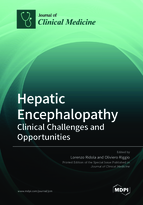Hepatic Encephalopathy: Clinical Challenges and Opportunities
A special issue of Journal of Clinical Medicine (ISSN 2077-0383). This special issue belongs to the section "Gastroenterology & Hepatopancreatobiliary Medicine".
Deadline for manuscript submissions: closed (31 August 2021) | Viewed by 40318
Special Issue Editors
Interests: portal hypertension; cirrhosis; hepatic encephalopathy; sarcopenia; TIPS
Special Issues, Collections and Topics in MDPI journals
Interests: hepatic encephalopathy; minimal hepatic encephalopathy; spontaneous portal-systemic shunts; transjugular intrahepatic portosystemic shunt; cirrhosis; portal hypertension; sarcopenia
Special Issues, Collections and Topics in MDPI journals
Special Issue Information
Dear Colleagues,
Hepatic encephalopathy (HE) is a complex neurological syndrome, characteristic of patients with liver disease, causing a wide and complex spectrum of nonspecific neurological and psychiatric manifestations, ranging from a subclinical entity, minimal or covert hepatic encephalopathy, to a deep form in which a complete alteration of consciousness can be observed: overt hepatic encephalopathy. Both minimal and overt hepatic encephalopathy have a high impact on patients, caregivers, and national health services, driving substantial consumption of economic resources. With this Special Issue, we hope to encourage submissions that discuss the current state-of-the-art, address ongoing knowledge gaps, and focus on ongoing controversies related to pathogenesis, diagnostic, and therapeutic management of hepatic encephalopathy.
Dr. Lorenzo Ridola
Prof. Oliviero Riggio
Guest Editors
Manuscript Submission Information
Manuscripts should be submitted online at www.mdpi.com by registering and logging in to this website. Once you are registered, click here to go to the submission form. Manuscripts can be submitted until the deadline. All submissions that pass pre-check are peer-reviewed. Accepted papers will be published continuously in the journal (as soon as accepted) and will be listed together on the special issue website. Research articles, review articles as well as short communications are invited. For planned papers, a title and short abstract (about 100 words) can be sent to the Editorial Office for announcement on this website.
Submitted manuscripts should not have been published previously, nor be under consideration for publication elsewhere (except conference proceedings papers). All manuscripts are thoroughly refereed through a single-blind peer-review process. A guide for authors and other relevant information for submission of manuscripts is available on the Instructions for Authors page. Journal of Clinical Medicine is an international peer-reviewed open access semimonthly journal published by MDPI.
Please visit the Instructions for Authors page before submitting a manuscript. The Article Processing Charge (APC) for publication in this open access journal is 2600 CHF (Swiss Francs). Submitted papers should be well formatted and use good English. Authors may use MDPI's English editing service prior to publication or during author revisions.
Keywords
- Hepatic encephalopathy
- Minimal hepatic encephalopathy
- Sarcopenia
- Spontaneous portal-systemic shunts
- Transjugular intrahepatic portosystemic shunt
- Portal hypertension
- Cirrhosis







